Analysis of Strategic Choice and Determinism in Organizational Theory
VerifiedAdded on 2023/06/04
|10
|2694
|447
Essay
AI Summary
This essay critically analyzes the contrasting perspectives of strategic choice and determinism within organizational theory. It begins by defining key organizational theories and their contributions to understanding organizational actions. The essay then delves into the strategic choice theory, emphasizing its focus on external environmental forces and their impact on relationships. Conversely, it explores the deterministic approach, highlighting how the external environment and market forces dictate organizational structure and behavior. The discussion encompasses resource dependency theory, institutional theory, and population ecology, evaluating their strengths and weaknesses. The essay highlights the ongoing debate between these perspectives and concludes by assessing the relative merits of each, ultimately arguing that both strategic choice and determinism have strengths and weaknesses, and that a combined approach may be most effective. The essay references several academic papers, including those by Anna, Dailey, Stein, Chiambaretto, Kondalkar, Bourgeois, Hillman, Bruton, Garcilazo, and Amirkabiri et al, to support its arguments. This essay provides a comprehensive overview of the core concepts and debates within organizational theory.
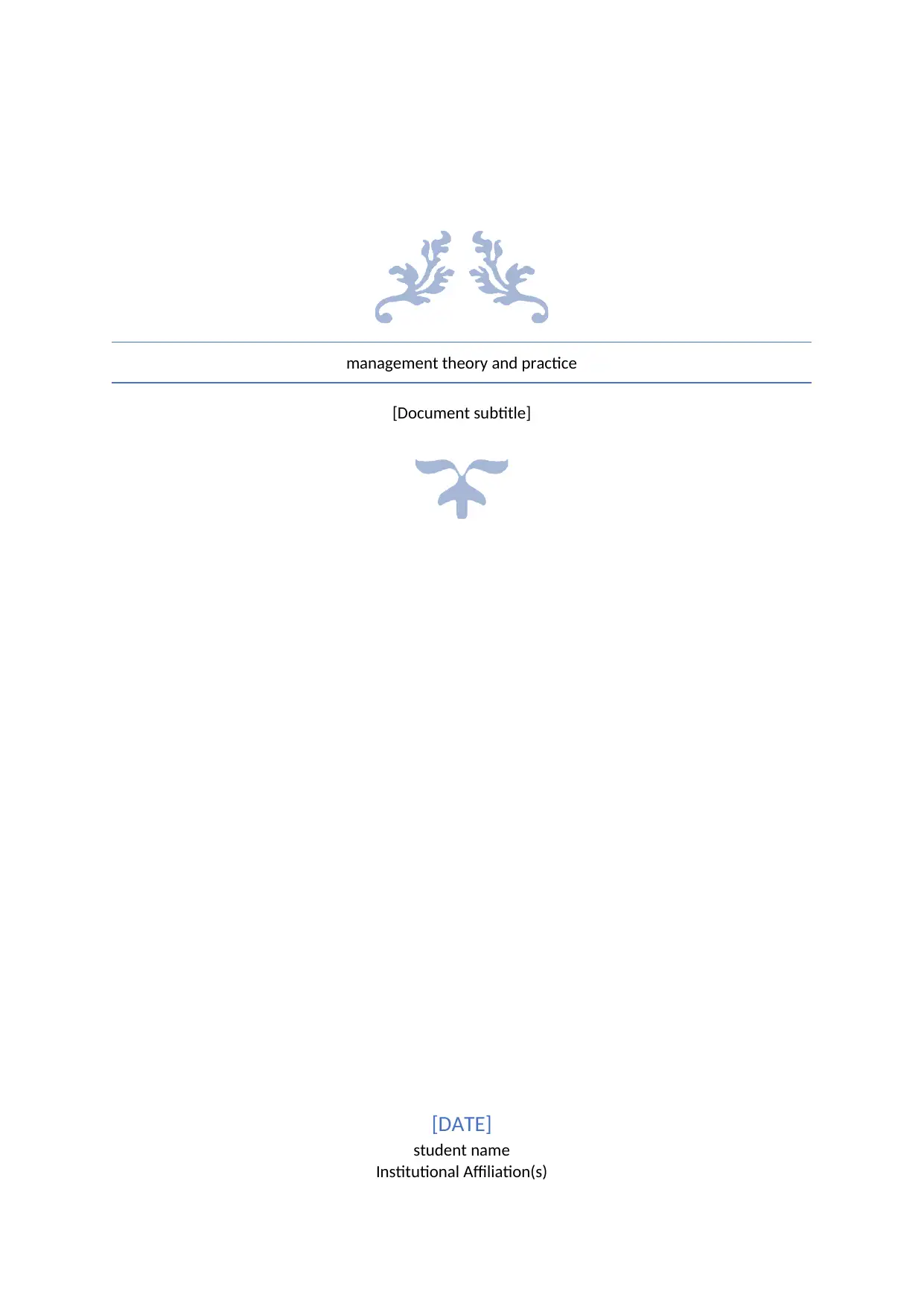
management theory and practice
[Document subtitle]
[DATE]
student name
Institutional Affiliation(s)
[Document subtitle]
[DATE]
student name
Institutional Affiliation(s)
Paraphrase This Document
Need a fresh take? Get an instant paraphrase of this document with our AI Paraphraser

P a g e | 1
Introduction
A very old expression says that business means war that reflects competitive mood
along with strategic nature of businesses in the world where every business rival competes
with each other to gain ultimate dominance in marketplace to access and utilise common
available resources. To compete, every business design and organises strategies and theories
that can make them unique from the others while performing business operations (Anna,
2015). Organisational theory can be defined as a study of organisational structure and design,
the study of organisational relationships with internal and external environment and study of
organisational behaviour among managers and individuals within a workplace. The validating
and analysing of the above stated assertions in which organisation theory is characterised as a
fragmented body of intellect having many competing theories that explains organisational
actions, this essay aims at discussing nature, meaning and scope of organisation theories. This
essay will commence with defining definitions of key theories contributing strategic choice
and determinism theories to understand the organisational actions. This essay will conclude
after summarising the prominent findings from the discussion made in present literature to
find out which perspective among strategic choice and determinism is most compelling.
Main body
According to Dailey (2012), organisation is a set or unit of people that are managed
and structured to meet an organisation’s goals. It is a collection of individuals who works
together under a labour division along with following hierarchy of authority to achieve a
common objective. Dailey (2012) refers organisations as a social arrangement that intends to
achieve a controlled performance while pursuing collective goals. Theory on the other hand
refers to those tested propositions, generally regarded as appropriate and used like a key
principle for explanation and prediction while performing a phenomenon in organisations.
Introduction
A very old expression says that business means war that reflects competitive mood
along with strategic nature of businesses in the world where every business rival competes
with each other to gain ultimate dominance in marketplace to access and utilise common
available resources. To compete, every business design and organises strategies and theories
that can make them unique from the others while performing business operations (Anna,
2015). Organisational theory can be defined as a study of organisational structure and design,
the study of organisational relationships with internal and external environment and study of
organisational behaviour among managers and individuals within a workplace. The validating
and analysing of the above stated assertions in which organisation theory is characterised as a
fragmented body of intellect having many competing theories that explains organisational
actions, this essay aims at discussing nature, meaning and scope of organisation theories. This
essay will commence with defining definitions of key theories contributing strategic choice
and determinism theories to understand the organisational actions. This essay will conclude
after summarising the prominent findings from the discussion made in present literature to
find out which perspective among strategic choice and determinism is most compelling.
Main body
According to Dailey (2012), organisation is a set or unit of people that are managed
and structured to meet an organisation’s goals. It is a collection of individuals who works
together under a labour division along with following hierarchy of authority to achieve a
common objective. Dailey (2012) refers organisations as a social arrangement that intends to
achieve a controlled performance while pursuing collective goals. Theory on the other hand
refers to those tested propositions, generally regarded as appropriate and used like a key
principle for explanation and prediction while performing a phenomenon in organisations.
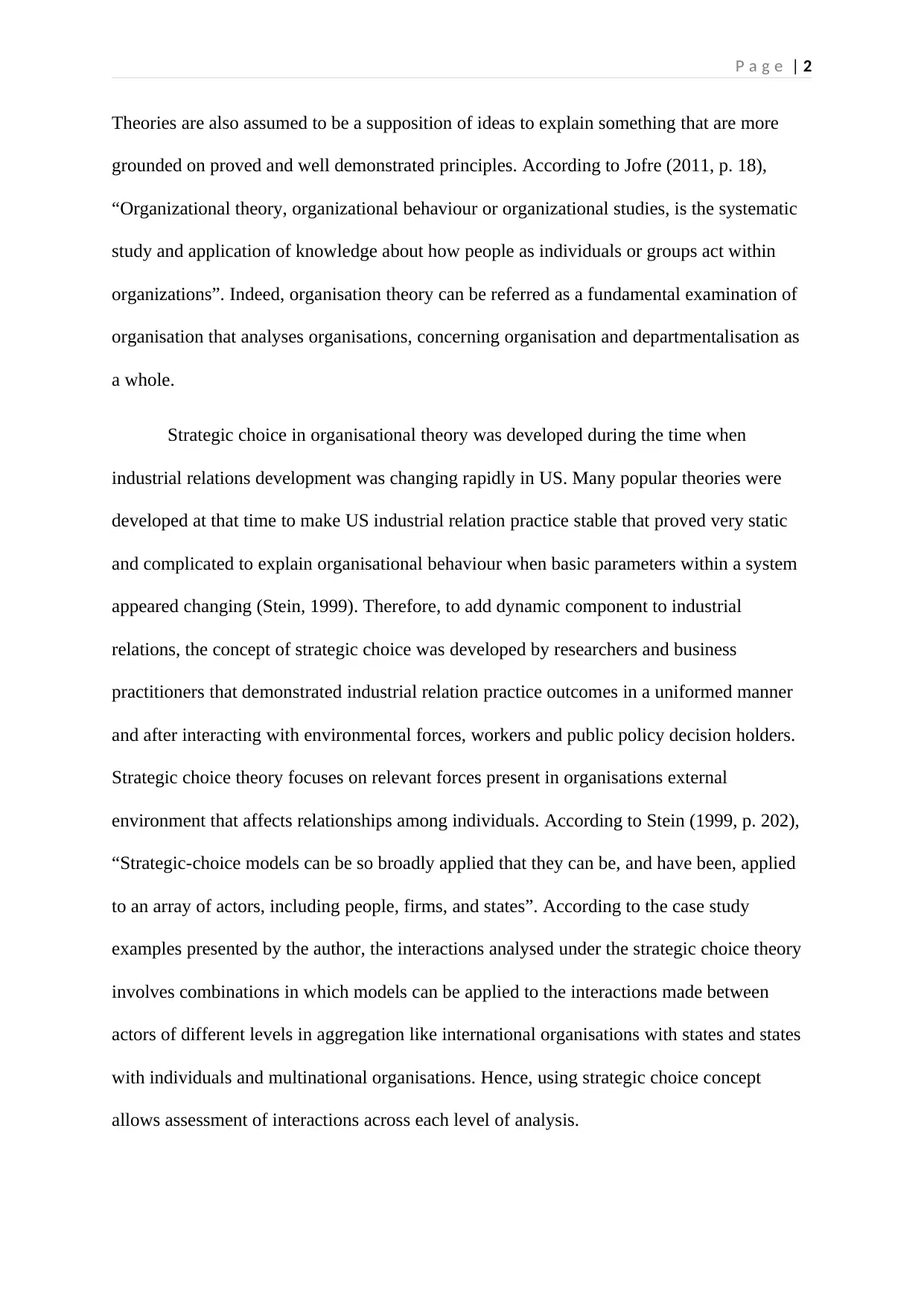
P a g e | 2
Theories are also assumed to be a supposition of ideas to explain something that are more
grounded on proved and well demonstrated principles. According to Jofre (2011, p. 18),
“Organizational theory, organizational behaviour or organizational studies, is the systematic
study and application of knowledge about how people as individuals or groups act within
organizations”. Indeed, organisation theory can be referred as a fundamental examination of
organisation that analyses organisations, concerning organisation and departmentalisation as
a whole.
Strategic choice in organisational theory was developed during the time when
industrial relations development was changing rapidly in US. Many popular theories were
developed at that time to make US industrial relation practice stable that proved very static
and complicated to explain organisational behaviour when basic parameters within a system
appeared changing (Stein, 1999). Therefore, to add dynamic component to industrial
relations, the concept of strategic choice was developed by researchers and business
practitioners that demonstrated industrial relation practice outcomes in a uniformed manner
and after interacting with environmental forces, workers and public policy decision holders.
Strategic choice theory focuses on relevant forces present in organisations external
environment that affects relationships among individuals. According to Stein (1999, p. 202),
“Strategic-choice models can be so broadly applied that they can be, and have been, applied
to an array of actors, including people, firms, and states”. According to the case study
examples presented by the author, the interactions analysed under the strategic choice theory
involves combinations in which models can be applied to the interactions made between
actors of different levels in aggregation like international organisations with states and states
with individuals and multinational organisations. Hence, using strategic choice concept
allows assessment of interactions across each level of analysis.
Theories are also assumed to be a supposition of ideas to explain something that are more
grounded on proved and well demonstrated principles. According to Jofre (2011, p. 18),
“Organizational theory, organizational behaviour or organizational studies, is the systematic
study and application of knowledge about how people as individuals or groups act within
organizations”. Indeed, organisation theory can be referred as a fundamental examination of
organisation that analyses organisations, concerning organisation and departmentalisation as
a whole.
Strategic choice in organisational theory was developed during the time when
industrial relations development was changing rapidly in US. Many popular theories were
developed at that time to make US industrial relation practice stable that proved very static
and complicated to explain organisational behaviour when basic parameters within a system
appeared changing (Stein, 1999). Therefore, to add dynamic component to industrial
relations, the concept of strategic choice was developed by researchers and business
practitioners that demonstrated industrial relation practice outcomes in a uniformed manner
and after interacting with environmental forces, workers and public policy decision holders.
Strategic choice theory focuses on relevant forces present in organisations external
environment that affects relationships among individuals. According to Stein (1999, p. 202),
“Strategic-choice models can be so broadly applied that they can be, and have been, applied
to an array of actors, including people, firms, and states”. According to the case study
examples presented by the author, the interactions analysed under the strategic choice theory
involves combinations in which models can be applied to the interactions made between
actors of different levels in aggregation like international organisations with states and states
with individuals and multinational organisations. Hence, using strategic choice concept
allows assessment of interactions across each level of analysis.
⊘ This is a preview!⊘
Do you want full access?
Subscribe today to unlock all pages.

Trusted by 1+ million students worldwide
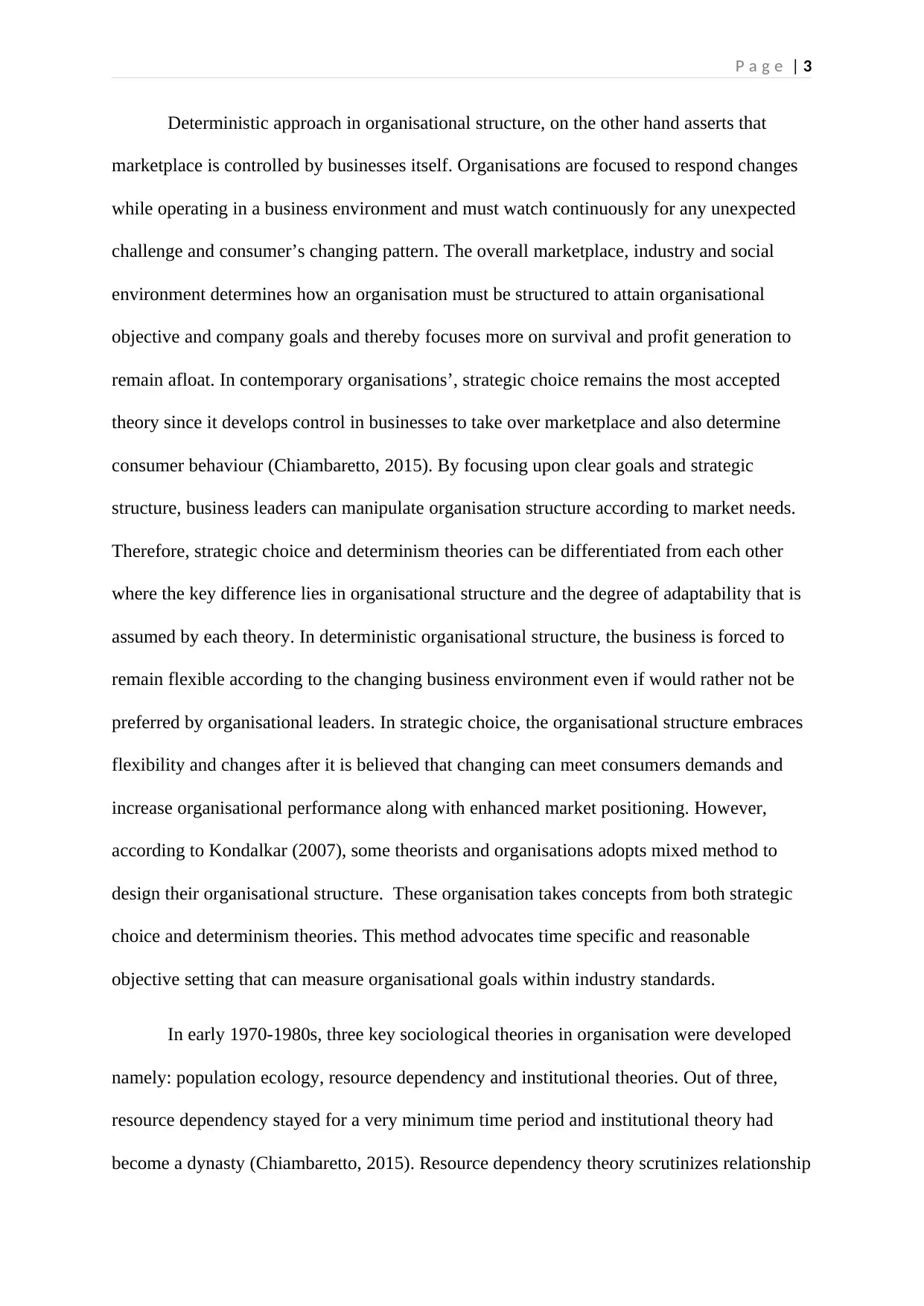
P a g e | 3
Deterministic approach in organisational structure, on the other hand asserts that
marketplace is controlled by businesses itself. Organisations are focused to respond changes
while operating in a business environment and must watch continuously for any unexpected
challenge and consumer’s changing pattern. The overall marketplace, industry and social
environment determines how an organisation must be structured to attain organisational
objective and company goals and thereby focuses more on survival and profit generation to
remain afloat. In contemporary organisations’, strategic choice remains the most accepted
theory since it develops control in businesses to take over marketplace and also determine
consumer behaviour (Chiambaretto, 2015). By focusing upon clear goals and strategic
structure, business leaders can manipulate organisation structure according to market needs.
Therefore, strategic choice and determinism theories can be differentiated from each other
where the key difference lies in organisational structure and the degree of adaptability that is
assumed by each theory. In deterministic organisational structure, the business is forced to
remain flexible according to the changing business environment even if would rather not be
preferred by organisational leaders. In strategic choice, the organisational structure embraces
flexibility and changes after it is believed that changing can meet consumers demands and
increase organisational performance along with enhanced market positioning. However,
according to Kondalkar (2007), some theorists and organisations adopts mixed method to
design their organisational structure. These organisation takes concepts from both strategic
choice and determinism theories. This method advocates time specific and reasonable
objective setting that can measure organisational goals within industry standards.
In early 1970-1980s, three key sociological theories in organisation were developed
namely: population ecology, resource dependency and institutional theories. Out of three,
resource dependency stayed for a very minimum time period and institutional theory had
become a dynasty (Chiambaretto, 2015). Resource dependency theory scrutinizes relationship
Deterministic approach in organisational structure, on the other hand asserts that
marketplace is controlled by businesses itself. Organisations are focused to respond changes
while operating in a business environment and must watch continuously for any unexpected
challenge and consumer’s changing pattern. The overall marketplace, industry and social
environment determines how an organisation must be structured to attain organisational
objective and company goals and thereby focuses more on survival and profit generation to
remain afloat. In contemporary organisations’, strategic choice remains the most accepted
theory since it develops control in businesses to take over marketplace and also determine
consumer behaviour (Chiambaretto, 2015). By focusing upon clear goals and strategic
structure, business leaders can manipulate organisation structure according to market needs.
Therefore, strategic choice and determinism theories can be differentiated from each other
where the key difference lies in organisational structure and the degree of adaptability that is
assumed by each theory. In deterministic organisational structure, the business is forced to
remain flexible according to the changing business environment even if would rather not be
preferred by organisational leaders. In strategic choice, the organisational structure embraces
flexibility and changes after it is believed that changing can meet consumers demands and
increase organisational performance along with enhanced market positioning. However,
according to Kondalkar (2007), some theorists and organisations adopts mixed method to
design their organisational structure. These organisation takes concepts from both strategic
choice and determinism theories. This method advocates time specific and reasonable
objective setting that can measure organisational goals within industry standards.
In early 1970-1980s, three key sociological theories in organisation were developed
namely: population ecology, resource dependency and institutional theories. Out of three,
resource dependency stayed for a very minimum time period and institutional theory had
become a dynasty (Chiambaretto, 2015). Resource dependency theory scrutinizes relationship
Paraphrase This Document
Need a fresh take? Get an instant paraphrase of this document with our AI Paraphraser

P a g e | 4
between organisations and resources in which they operate in. Resources can further be
divided into various forms and shapes including workers, raw materials and funding’s. If one
organisation maintains majority of resources, then other company will become dependent on
it to remain operating in market, thereby creating a symbiotic relationship. Too much
dependency can create dependency and uncertainty that leave organisations’ subject to risk
and ambiguity of external control. These external controls can be referred as impositions
made by government and other organisations’ that can have significant effects on
organisational performances such as personnel policies and financial incentives. When
developed, resource dependency had greatest influence out of all especially in 1980s period
when it provided organisations with great potential to develop coherent research
communities. At that time, it appeared as a deterministic approach, but gradually a reversed
trend came in front when organisations started implementing ecology population in their
strategies.
According to Bourgeois (1984, p. 593), “Most strategic management researchers
undoubtedly are sympathetic to the argument that it is the "degrees of strategic freedom" that
are important rather than an absolute choice between determinism and free will”. However,
resource dependency perspective provides organisations in understanding the nature of joint
ventures and other interorganisational activities like strategic alliances and joint-marketing
agreements is suggested by Hillman et al. (2009). Empirical research made by Pfeffer &
Nowak supports resource dependency concept to reduce international and domestic
environmental complexity to gain resources. According to the authors, the balance between
powers held by international partners and finding alliances occur when organisations
becomes mutually dependent on each other, but the partner who controls more resources
retains strategic governance. Jofre (2011) finds that if one partner accumulates major
resources from others, the venture then becomes less table and thus this misappropriation
between organisations and resources in which they operate in. Resources can further be
divided into various forms and shapes including workers, raw materials and funding’s. If one
organisation maintains majority of resources, then other company will become dependent on
it to remain operating in market, thereby creating a symbiotic relationship. Too much
dependency can create dependency and uncertainty that leave organisations’ subject to risk
and ambiguity of external control. These external controls can be referred as impositions
made by government and other organisations’ that can have significant effects on
organisational performances such as personnel policies and financial incentives. When
developed, resource dependency had greatest influence out of all especially in 1980s period
when it provided organisations with great potential to develop coherent research
communities. At that time, it appeared as a deterministic approach, but gradually a reversed
trend came in front when organisations started implementing ecology population in their
strategies.
According to Bourgeois (1984, p. 593), “Most strategic management researchers
undoubtedly are sympathetic to the argument that it is the "degrees of strategic freedom" that
are important rather than an absolute choice between determinism and free will”. However,
resource dependency perspective provides organisations in understanding the nature of joint
ventures and other interorganisational activities like strategic alliances and joint-marketing
agreements is suggested by Hillman et al. (2009). Empirical research made by Pfeffer &
Nowak supports resource dependency concept to reduce international and domestic
environmental complexity to gain resources. According to the authors, the balance between
powers held by international partners and finding alliances occur when organisations
becomes mutually dependent on each other, but the partner who controls more resources
retains strategic governance. Jofre (2011) finds that if one partner accumulates major
resources from others, the venture then becomes less table and thus this misappropriation
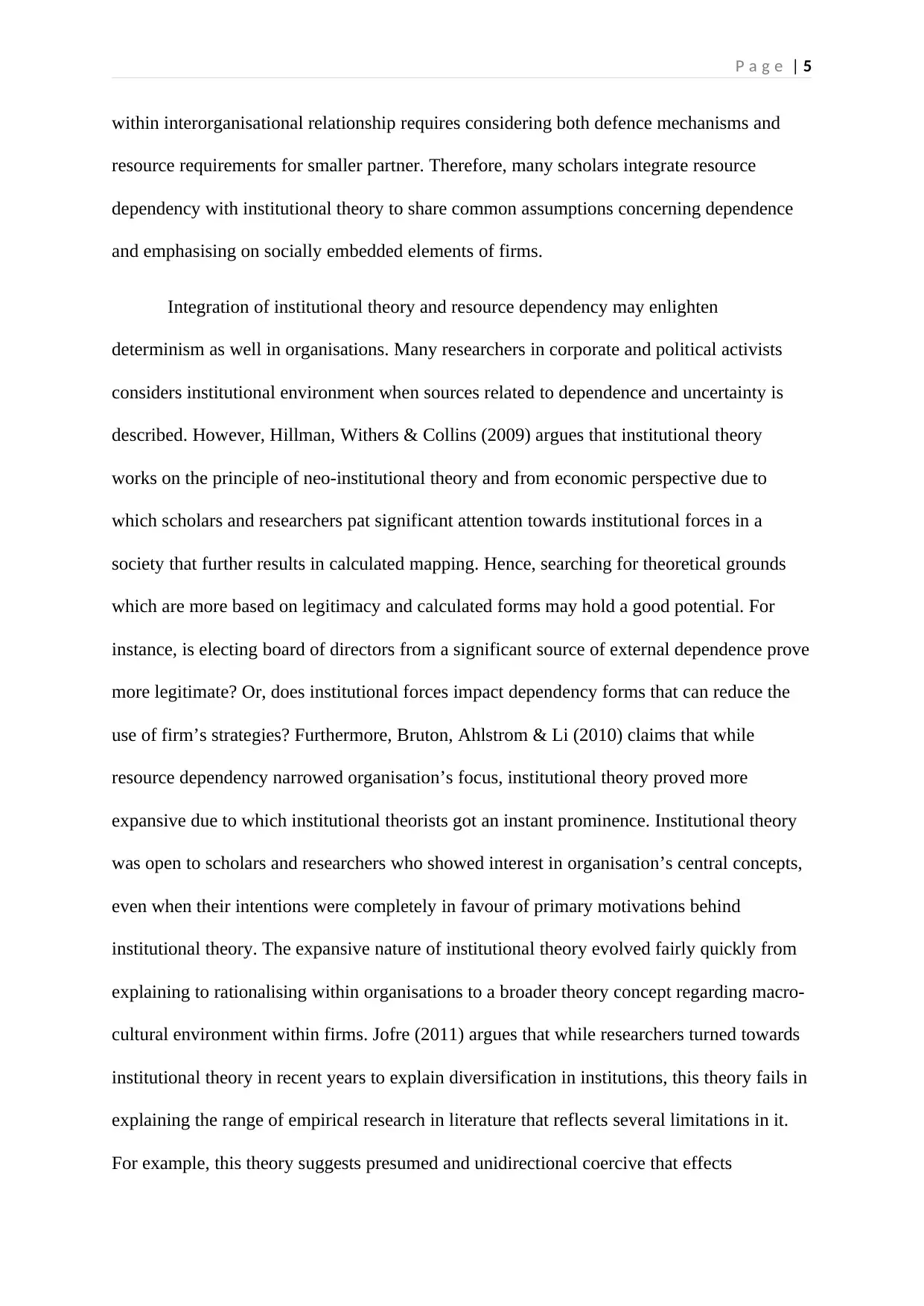
P a g e | 5
within interorganisational relationship requires considering both defence mechanisms and
resource requirements for smaller partner. Therefore, many scholars integrate resource
dependency with institutional theory to share common assumptions concerning dependence
and emphasising on socially embedded elements of firms.
Integration of institutional theory and resource dependency may enlighten
determinism as well in organisations. Many researchers in corporate and political activists
considers institutional environment when sources related to dependence and uncertainty is
described. However, Hillman, Withers & Collins (2009) argues that institutional theory
works on the principle of neo-institutional theory and from economic perspective due to
which scholars and researchers pat significant attention towards institutional forces in a
society that further results in calculated mapping. Hence, searching for theoretical grounds
which are more based on legitimacy and calculated forms may hold a good potential. For
instance, is electing board of directors from a significant source of external dependence prove
more legitimate? Or, does institutional forces impact dependency forms that can reduce the
use of firm’s strategies? Furthermore, Bruton, Ahlstrom & Li (2010) claims that while
resource dependency narrowed organisation’s focus, institutional theory proved more
expansive due to which institutional theorists got an instant prominence. Institutional theory
was open to scholars and researchers who showed interest in organisation’s central concepts,
even when their intentions were completely in favour of primary motivations behind
institutional theory. The expansive nature of institutional theory evolved fairly quickly from
explaining to rationalising within organisations to a broader theory concept regarding macro-
cultural environment within firms. Jofre (2011) argues that while researchers turned towards
institutional theory in recent years to explain diversification in institutions, this theory fails in
explaining the range of empirical research in literature that reflects several limitations in it.
For example, this theory suggests presumed and unidirectional coercive that effects
within interorganisational relationship requires considering both defence mechanisms and
resource requirements for smaller partner. Therefore, many scholars integrate resource
dependency with institutional theory to share common assumptions concerning dependence
and emphasising on socially embedded elements of firms.
Integration of institutional theory and resource dependency may enlighten
determinism as well in organisations. Many researchers in corporate and political activists
considers institutional environment when sources related to dependence and uncertainty is
described. However, Hillman, Withers & Collins (2009) argues that institutional theory
works on the principle of neo-institutional theory and from economic perspective due to
which scholars and researchers pat significant attention towards institutional forces in a
society that further results in calculated mapping. Hence, searching for theoretical grounds
which are more based on legitimacy and calculated forms may hold a good potential. For
instance, is electing board of directors from a significant source of external dependence prove
more legitimate? Or, does institutional forces impact dependency forms that can reduce the
use of firm’s strategies? Furthermore, Bruton, Ahlstrom & Li (2010) claims that while
resource dependency narrowed organisation’s focus, institutional theory proved more
expansive due to which institutional theorists got an instant prominence. Institutional theory
was open to scholars and researchers who showed interest in organisation’s central concepts,
even when their intentions were completely in favour of primary motivations behind
institutional theory. The expansive nature of institutional theory evolved fairly quickly from
explaining to rationalising within organisations to a broader theory concept regarding macro-
cultural environment within firms. Jofre (2011) argues that while researchers turned towards
institutional theory in recent years to explain diversification in institutions, this theory fails in
explaining the range of empirical research in literature that reflects several limitations in it.
For example, this theory suggests presumed and unidirectional coercive that effects
⊘ This is a preview!⊘
Do you want full access?
Subscribe today to unlock all pages.

Trusted by 1+ million students worldwide
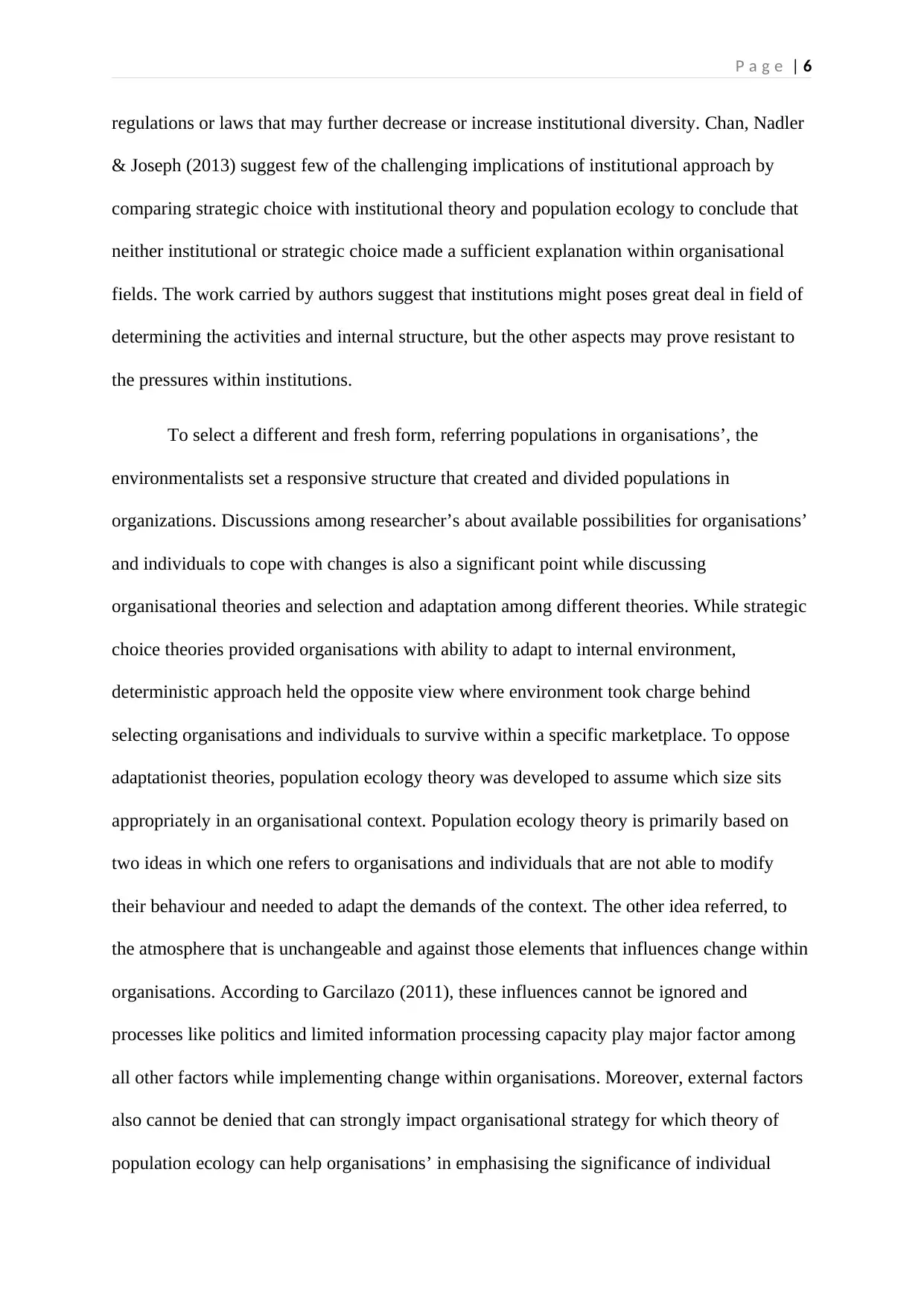
P a g e | 6
regulations or laws that may further decrease or increase institutional diversity. Chan, Nadler
& Joseph (2013) suggest few of the challenging implications of institutional approach by
comparing strategic choice with institutional theory and population ecology to conclude that
neither institutional or strategic choice made a sufficient explanation within organisational
fields. The work carried by authors suggest that institutions might poses great deal in field of
determining the activities and internal structure, but the other aspects may prove resistant to
the pressures within institutions.
To select a different and fresh form, referring populations in organisations’, the
environmentalists set a responsive structure that created and divided populations in
organizations. Discussions among researcher’s about available possibilities for organisations’
and individuals to cope with changes is also a significant point while discussing
organisational theories and selection and adaptation among different theories. While strategic
choice theories provided organisations with ability to adapt to internal environment,
deterministic approach held the opposite view where environment took charge behind
selecting organisations and individuals to survive within a specific marketplace. To oppose
adaptationist theories, population ecology theory was developed to assume which size sits
appropriately in an organisational context. Population ecology theory is primarily based on
two ideas in which one refers to organisations and individuals that are not able to modify
their behaviour and needed to adapt the demands of the context. The other idea referred, to
the atmosphere that is unchangeable and against those elements that influences change within
organisations. According to Garcilazo (2011), these influences cannot be ignored and
processes like politics and limited information processing capacity play major factor among
all other factors while implementing change within organisations. Moreover, external factors
also cannot be denied that can strongly impact organisational strategy for which theory of
population ecology can help organisations’ in emphasising the significance of individual
regulations or laws that may further decrease or increase institutional diversity. Chan, Nadler
& Joseph (2013) suggest few of the challenging implications of institutional approach by
comparing strategic choice with institutional theory and population ecology to conclude that
neither institutional or strategic choice made a sufficient explanation within organisational
fields. The work carried by authors suggest that institutions might poses great deal in field of
determining the activities and internal structure, but the other aspects may prove resistant to
the pressures within institutions.
To select a different and fresh form, referring populations in organisations’, the
environmentalists set a responsive structure that created and divided populations in
organizations. Discussions among researcher’s about available possibilities for organisations’
and individuals to cope with changes is also a significant point while discussing
organisational theories and selection and adaptation among different theories. While strategic
choice theories provided organisations with ability to adapt to internal environment,
deterministic approach held the opposite view where environment took charge behind
selecting organisations and individuals to survive within a specific marketplace. To oppose
adaptationist theories, population ecology theory was developed to assume which size sits
appropriately in an organisational context. Population ecology theory is primarily based on
two ideas in which one refers to organisations and individuals that are not able to modify
their behaviour and needed to adapt the demands of the context. The other idea referred, to
the atmosphere that is unchangeable and against those elements that influences change within
organisations. According to Garcilazo (2011), these influences cannot be ignored and
processes like politics and limited information processing capacity play major factor among
all other factors while implementing change within organisations. Moreover, external factors
also cannot be denied that can strongly impact organisational strategy for which theory of
population ecology can help organisations’ in emphasising the significance of individual
Paraphrase This Document
Need a fresh take? Get an instant paraphrase of this document with our AI Paraphraser
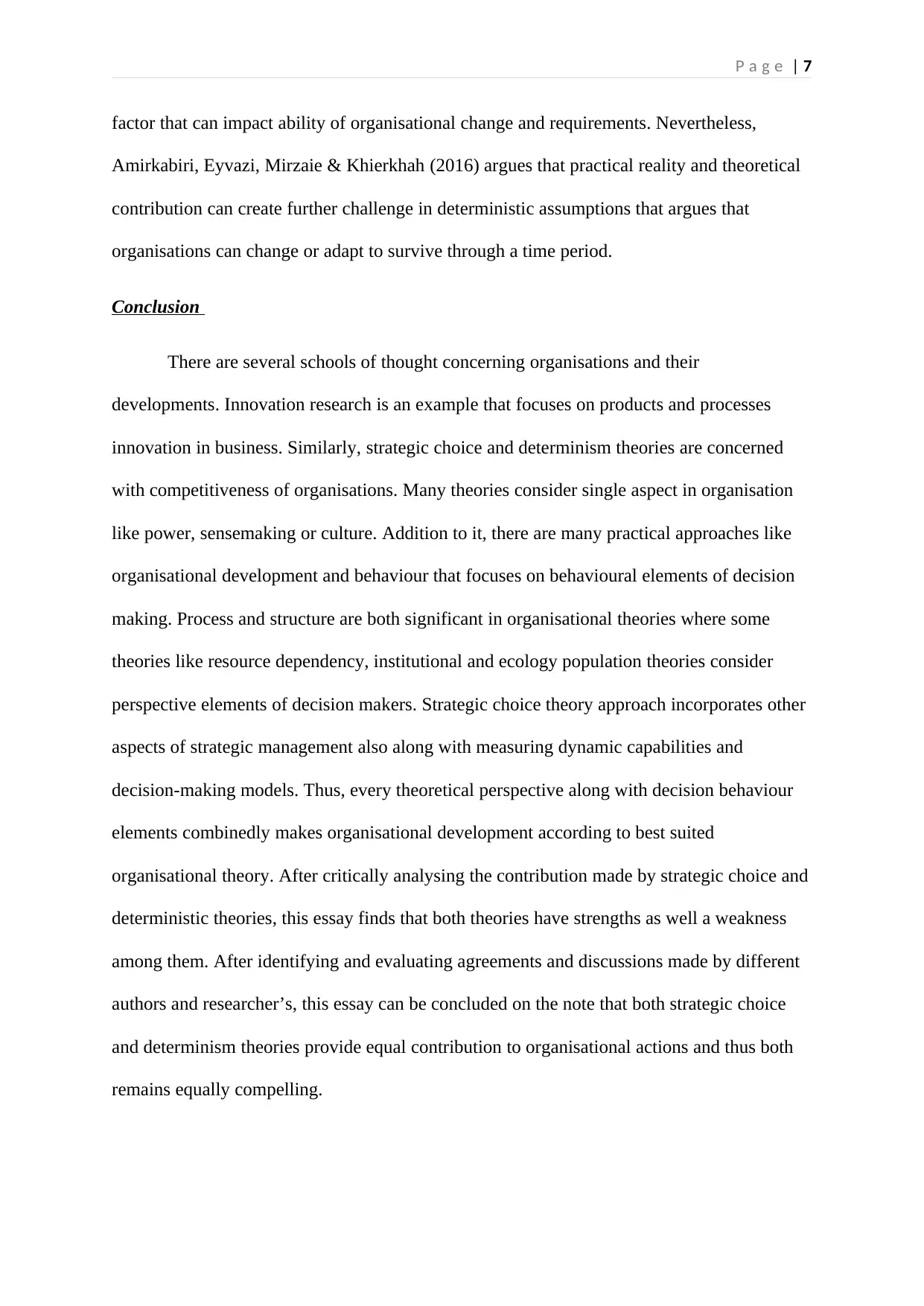
P a g e | 7
factor that can impact ability of organisational change and requirements. Nevertheless,
Amirkabiri, Eyvazi, Mirzaie & Khierkhah (2016) argues that practical reality and theoretical
contribution can create further challenge in deterministic assumptions that argues that
organisations can change or adapt to survive through a time period.
Conclusion
There are several schools of thought concerning organisations and their
developments. Innovation research is an example that focuses on products and processes
innovation in business. Similarly, strategic choice and determinism theories are concerned
with competitiveness of organisations. Many theories consider single aspect in organisation
like power, sensemaking or culture. Addition to it, there are many practical approaches like
organisational development and behaviour that focuses on behavioural elements of decision
making. Process and structure are both significant in organisational theories where some
theories like resource dependency, institutional and ecology population theories consider
perspective elements of decision makers. Strategic choice theory approach incorporates other
aspects of strategic management also along with measuring dynamic capabilities and
decision-making models. Thus, every theoretical perspective along with decision behaviour
elements combinedly makes organisational development according to best suited
organisational theory. After critically analysing the contribution made by strategic choice and
deterministic theories, this essay finds that both theories have strengths as well a weakness
among them. After identifying and evaluating agreements and discussions made by different
authors and researcher’s, this essay can be concluded on the note that both strategic choice
and determinism theories provide equal contribution to organisational actions and thus both
remains equally compelling.
factor that can impact ability of organisational change and requirements. Nevertheless,
Amirkabiri, Eyvazi, Mirzaie & Khierkhah (2016) argues that practical reality and theoretical
contribution can create further challenge in deterministic assumptions that argues that
organisations can change or adapt to survive through a time period.
Conclusion
There are several schools of thought concerning organisations and their
developments. Innovation research is an example that focuses on products and processes
innovation in business. Similarly, strategic choice and determinism theories are concerned
with competitiveness of organisations. Many theories consider single aspect in organisation
like power, sensemaking or culture. Addition to it, there are many practical approaches like
organisational development and behaviour that focuses on behavioural elements of decision
making. Process and structure are both significant in organisational theories where some
theories like resource dependency, institutional and ecology population theories consider
perspective elements of decision makers. Strategic choice theory approach incorporates other
aspects of strategic management also along with measuring dynamic capabilities and
decision-making models. Thus, every theoretical perspective along with decision behaviour
elements combinedly makes organisational development according to best suited
organisational theory. After critically analysing the contribution made by strategic choice and
deterministic theories, this essay finds that both theories have strengths as well a weakness
among them. After identifying and evaluating agreements and discussions made by different
authors and researcher’s, this essay can be concluded on the note that both strategic choice
and determinism theories provide equal contribution to organisational actions and thus both
remains equally compelling.

P a g e | 8
References
Amirkabiri, A., Eyvazi, M., Mirzaie, M. H. & Kheirkhah, M., 2016. The Study of Population
Ecology Approach to Organisation. The Turkish Online Journal of Design, Art and
Communication, 2076-2079.
Anna, A., 2015. Strategic Management Tools and Techniques and Organizational
Performance: Findings from the Czech Republic. Journal of Competitiveness , 07(03): 19-36.
Bourgeois, L. J., 1984. Strategic Management and Determinism. Academy of Management
Review, 09(04): 586-596.
Bruton, G. D., Ahlstrom, D. & Li, H.-L., 2010. Institutional Theory and Entrepreneurship:
Where Are We Now and Where Do We Need to Move in the Future?. Entrepreneurship:
Theory and Practice, 34(03): 421-440.
Chan, Y. H., Nadler, S. S. & Joseph, C. D., 2013. Integrating the Techno-Economic Cycle
with Population Ecology Theory to Explain the Evolution of Organization Forms. American
International Journal of Contemporary Research, 03(12): 8-18.
Chiambaretto, P., 2015. Resource Dependence and Power-Balancing Operations in Alliances:
The Role of Market Redefinition Strategies. Management, 08(03): 205-233.
Dailey, R., 2012. Organisational Behaviour. s.l.:Edinburgh Business School .
Garcilazo, J., 2011. The Theory of the Population Ecology considered by the Adaptation
Theories. Visión de Futuro, 05(01).
References
Amirkabiri, A., Eyvazi, M., Mirzaie, M. H. & Kheirkhah, M., 2016. The Study of Population
Ecology Approach to Organisation. The Turkish Online Journal of Design, Art and
Communication, 2076-2079.
Anna, A., 2015. Strategic Management Tools and Techniques and Organizational
Performance: Findings from the Czech Republic. Journal of Competitiveness , 07(03): 19-36.
Bourgeois, L. J., 1984. Strategic Management and Determinism. Academy of Management
Review, 09(04): 586-596.
Bruton, G. D., Ahlstrom, D. & Li, H.-L., 2010. Institutional Theory and Entrepreneurship:
Where Are We Now and Where Do We Need to Move in the Future?. Entrepreneurship:
Theory and Practice, 34(03): 421-440.
Chan, Y. H., Nadler, S. S. & Joseph, C. D., 2013. Integrating the Techno-Economic Cycle
with Population Ecology Theory to Explain the Evolution of Organization Forms. American
International Journal of Contemporary Research, 03(12): 8-18.
Chiambaretto, P., 2015. Resource Dependence and Power-Balancing Operations in Alliances:
The Role of Market Redefinition Strategies. Management, 08(03): 205-233.
Dailey, R., 2012. Organisational Behaviour. s.l.:Edinburgh Business School .
Garcilazo, J., 2011. The Theory of the Population Ecology considered by the Adaptation
Theories. Visión de Futuro, 05(01).
⊘ This is a preview!⊘
Do you want full access?
Subscribe today to unlock all pages.

Trusted by 1+ million students worldwide
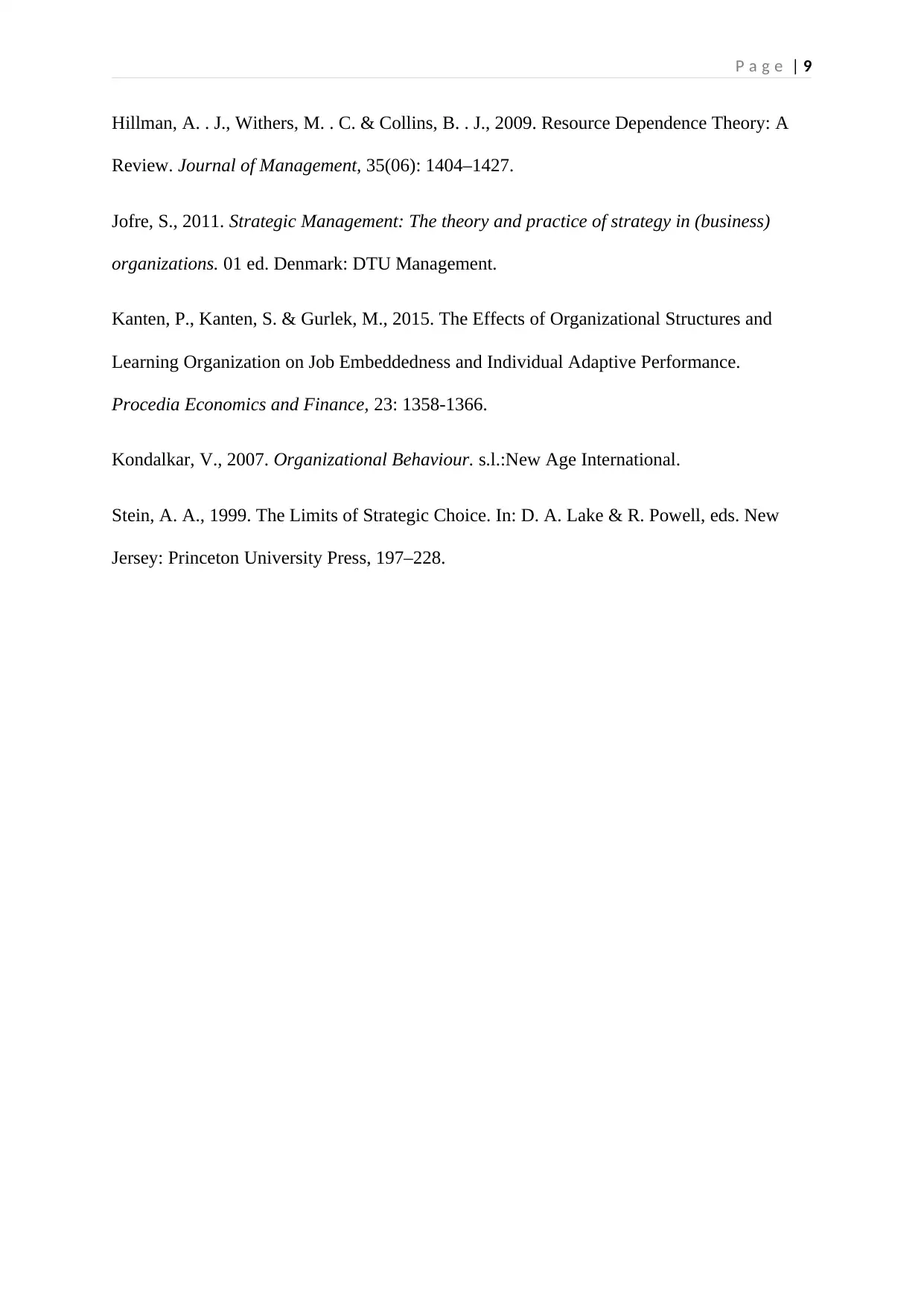
P a g e | 9
Hillman, A. . J., Withers, M. . C. & Collins, B. . J., 2009. Resource Dependence Theory: A
Review. Journal of Management, 35(06): 1404–1427.
Jofre, S., 2011. Strategic Management: The theory and practice of strategy in (business)
organizations. 01 ed. Denmark: DTU Management.
Kanten, P., Kanten, S. & Gurlek, M., 2015. The Effects of Organizational Structures and
Learning Organization on Job Embeddedness and Individual Adaptive Performance.
Procedia Economics and Finance, 23: 1358-1366.
Kondalkar, V., 2007. Organizational Behaviour. s.l.:New Age International.
Stein, A. A., 1999. The Limits of Strategic Choice. In: D. A. Lake & R. Powell, eds. New
Jersey: Princeton University Press, 197–228.
Hillman, A. . J., Withers, M. . C. & Collins, B. . J., 2009. Resource Dependence Theory: A
Review. Journal of Management, 35(06): 1404–1427.
Jofre, S., 2011. Strategic Management: The theory and practice of strategy in (business)
organizations. 01 ed. Denmark: DTU Management.
Kanten, P., Kanten, S. & Gurlek, M., 2015. The Effects of Organizational Structures and
Learning Organization on Job Embeddedness and Individual Adaptive Performance.
Procedia Economics and Finance, 23: 1358-1366.
Kondalkar, V., 2007. Organizational Behaviour. s.l.:New Age International.
Stein, A. A., 1999. The Limits of Strategic Choice. In: D. A. Lake & R. Powell, eds. New
Jersey: Princeton University Press, 197–228.
1 out of 10
Related Documents
Your All-in-One AI-Powered Toolkit for Academic Success.
+13062052269
info@desklib.com
Available 24*7 on WhatsApp / Email
![[object Object]](/_next/static/media/star-bottom.7253800d.svg)
Unlock your academic potential
Copyright © 2020–2025 A2Z Services. All Rights Reserved. Developed and managed by ZUCOL.




